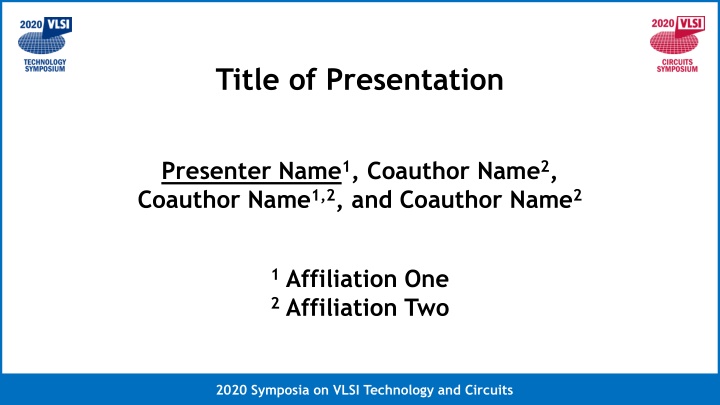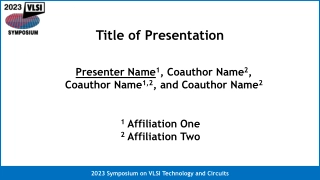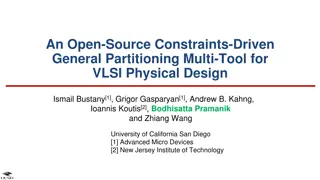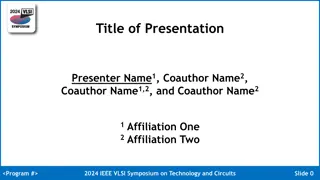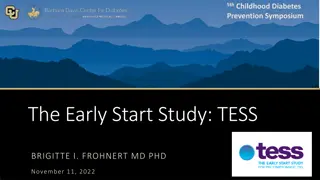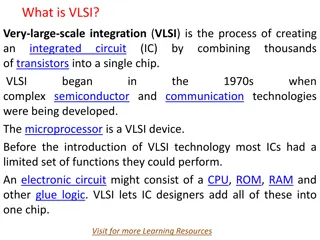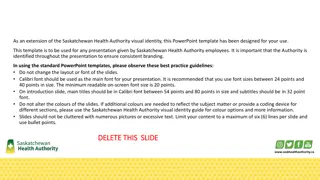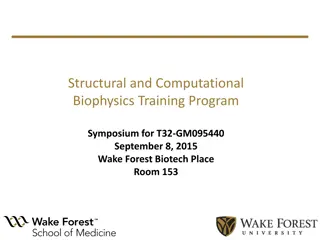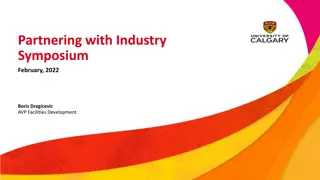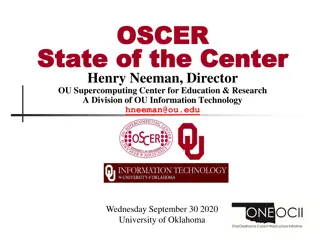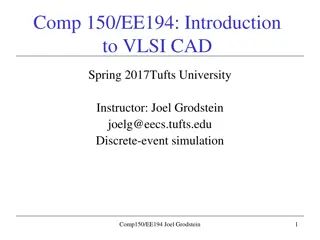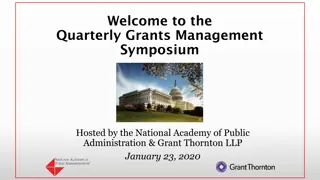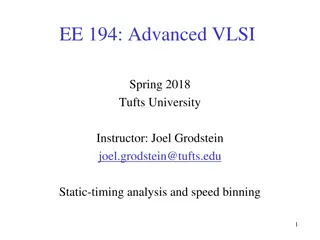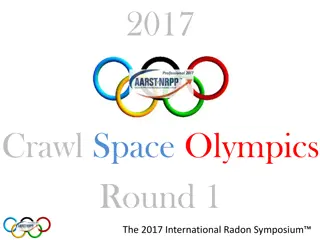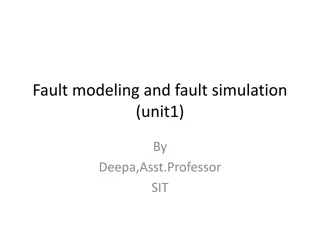Guidelines for Effective Presentations at 2020 VLSI Technology Symposium
Create impactful presentations for the 2020 VLSI Technology Symposium by following guidelines on slide format, font sizes, and content layout. Ensure your slides are concise, visually appealing, and focused on key concepts. Embrace simplicity, use simple diagrams, avoid complex equations, and rehearse your presentation aloud. Adhere to requirements regarding slide sizing, fonts, and title slide information to enhance the quality of your presentation.
Download Presentation

Please find below an Image/Link to download the presentation.
The content on the website is provided AS IS for your information and personal use only. It may not be sold, licensed, or shared on other websites without obtaining consent from the author.If you encounter any issues during the download, it is possible that the publisher has removed the file from their server.
You are allowed to download the files provided on this website for personal or commercial use, subject to the condition that they are used lawfully. All files are the property of their respective owners.
The content on the website is provided AS IS for your information and personal use only. It may not be sold, licensed, or shared on other websites without obtaining consent from the author.
E N D
Presentation Transcript
Title of Presentation Presenter Name1, Coauthor Name2, Coauthor Name1,2, and Coauthor Name2 1Affiliation One 2Affiliation Two 2020 Symposia on VLSI Technology and Circuits
Outline Slide Format Title Slide Font Size Presentation Guidelines Presentation Flow Text Slides Graphs and Diagrams Saving Uploading 2020 Symposia on VLSI Technology and Circuits Slide 1 SessionID (e.g., TF1.4 or CB2.3)
Slide Format Requirements Slides must be sized for Widescreen format (16:9) with 0.5 in margins. Slide orientation must be Landscape (horizontal). In DESIGN tab, click on Slide Size and then select Widescreen. In Custom Slide Size, you will see: 2020 Symposia on VLSI Technology and Circuits Slide 2 SessionID (e.g., TF1.4 or CB2.3)
Slide Format Rules Corporate and institutional logos are not permitted, except on the title slide. Corporate and institutional backgrounds and borders are not permitted to avoid appearance of marketing. Backgrounds must be white. Text, lines, and shape outlines must be dark. Text fonts must be appropriate for screen display. Recommended font: Trebuchet MS Reasonable alternatives: Arial or Verdana. 2020 Symposia on VLSI Technology and Circuits Slide 3 SessionID (e.g., TF1.4 or CB2.3)
Title Slide Requirements Title slide must include: title of presentation, names and affiliations of all authors, and full name of presenter. Full name of presenter must be underlined. Superscripts may be used to indicate individual author affiliations. 2020 Symposia on VLSI Technology and Circuits Slide 4 SessionID (e.g., TF1.4 or CB2.3)
Font Size Rules Title font size must be 40 pt. Primary text font size must be 28 pt. Secondary text font size must be 24 pt. All other text font size should be 24 pt, unless a smaller font is absolutely necessary. Font sizes (including labels on diagrams & graphs) must always be 20 pt. 2020 Symposia on VLSI Technology and Circuits Slide 5 SessionID (e.g., TF1.4 or CB2.3)
Guidelines for Effective Presentations Keep concepts as simple as possible. Limit each slide to one main idea. Use several simple diagrams rather than one complex diagram. Use equations only if concepts cannot be clearly explained without equations. Use duplicate copies of slides that will be used more than once during the presentation. Do not plan to go back to a slide during the presentation. Rehearse the presentation aloud, preferably to a group of colleagues. 2020 Symposia on VLSI Technology and Circuits Slide 6 SessionID (e.g., TF1.4 or CB2.3)
Additional Guidelines for Effective Recorded Presentations Practice transition sentences as you advance to the next slide to sound more cohesive. Unless you are the only author, use we instead of I . Motion on the screen is useful to engage the audience attention of a streamed presentation. It is strongly recommended that you embed a video of you talking in a corner of the slideshow. If embedded video, it is best to leave a corner of the slide blank. Additionally, use animation (slide 11) and use the embedded pointing tools within Powerpoint to help focus viewers attention. 2020 Symposia on VLSI Technology and Circuits Slide 7 SessionID (e.g., TF1.4 or CB2.3)
Presentation Flow Title Slide Outline Slide (outline of the presentation, not the paper) Introduction, Motivation, Problems or Challenges Details of Work Comparison of Results with Previously Reported Work Conclusion Slide Backup Slide(s) (for potential use during question & answer period) 2020 Symposia on VLSI Technology and Circuits Slide 8 SessionID (e.g., TF1.4 or CB2.3)
Use Outline Slide as Section Breaks Title Slide Outline Slide (outline of the presentation, not the paper) Introduction, Motivation, Problems or Challenges Gray out surrounding text Details of Work Comparison of Results with Previously Reported Work Conclusion Slide Backup Slide(s) (for potential use during question & answer period) 2020 Symposia on VLSI Technology and Circuits Slide 9 SessionID (e.g., TF1.4 or CB2.3)
Text Slides Use short phrases, not long sentences. OK to remove articles like a , an , and the Slides with lots of words are hard for the audience to assimilate. Minimize the number of words on text slides. Unless necessary: Use no more than 30 words per slide, and Use no more than 6 lines of text per slide. Acknowledgments not Acknowledgements . Might be useful to have slides checked by native English speaker. Please indicate early if you would like additional help from your session chair/co-chair 2020 Symposia on VLSI Technology and Circuits Slide 10 SessionID (e.g., TF1.4 or CB2.3)
Successively Focus Audience on Slide Content Within a slide, use simple animation to make things Appear successively within a slide. Check the animation in Slide Show mode (see this slide as an example) Make sure your speech integrates well with the timing of the animation This creates change to your screen every 5-15 seconds instead of roughly every minute Don t use fancy animation as it may come across as a distraction 2020 Symposia on VLSI Technology and Circuits Slide 11 SessionID (e.g., TF1.4 or CB2.3)
Slide Footer Go to View tab and click on Slide Master Update bottom right footer with your Paper ID Examples: T2-4 (Technology Symposium, Session 2, Paper 4) C2-4 (Circuits Symposium, Session 2, Paper 4) JFS2-4 (Joint Focus Session 2, Paper 4) SC1-5 (Short Course 1, 5th presentation) FF-2 (Friday Forum, 2nd presentation) Do not delete bottom right footer Slide <#> To exit, go to Slide Master tab and click on Close Master 2020 Symposia on VLSI Technology and Circuits Slide 12 SessionID (e.g., TF1.4 or CB2.3)
Graphs and Diagrams Simple line drawings are often best. Make all lines sufficiently thick. Dotted, dashed, and other specialty lines should be very bold and thick. Do not simply copy-and-paste figures from your paper. Fonts within graphs and diagrams should be 24 pt. Often, graphs imported from other applications (e.g., Matlab) have small fonts & thin lines. Adjust settings of the applications to increase font size and line thickness, or Import data and produce graphs using PowerPoint. Annotating plots with text may be easier to follow than using a legend Avoid red lines in black as color-blind people have difficulty seeing red Apply shadow to your text inside figures if more contrast is needed 2020 Symposia on VLSI Technology and Circuits Slide 13 SessionID (e.g., TF1.4 or CB2.3)
Example of Good Figure Simple Graph, Thick Lines, Large Fonts 1.5 1 IDSAT Anneal 1 Anneal 2 Anneal 3 (mA / m) 0.5 0 0 1 2 3 4 5 6 EOT (nm) 2020 Symposia on VLSI Technology and Circuits Slide 14 SessionID (e.g., TF1.4 or CB2.3)
Example of Bad Figure Thin Lines, Small Fonts 1.4 Anneal 1 1.2 Anneal 2 Anneal 3 1 IDSAT (mA/um) 0.8 0.6 0.4 0.2 0 0 2 4 6 EOT (nm) 2020 Symposia on VLSI Technology and Circuits Slide 15 SessionID (e.g., TF1.4 or CB2.3)
Saving your File Embed TrueType fonts in your file Click on File , Save As , Tools , Embed True Type Fonts , or Click on File , Save As , and check Embed True Type Save your file with the name pattern SID.pdf (PDF) SID: Session ID number (found in front of your title) Examples: TM2.1.pdf (Technology Symposium, Session M, Paper 1) CA3.4.pdf (Circuits Symposium, Session A, Paper 4) JFS2.4.pdf (Joint Focus Session 2, Paper 4) SC1.5.pdf (Short Course 1, 5th presentation) FF.2.pdf (Friday Forum, 2nd presentation) 2020 Symposia on VLSI Technology and Circuits Slide 16 SessionID (e.g., TF1.4 or CB2.3)
